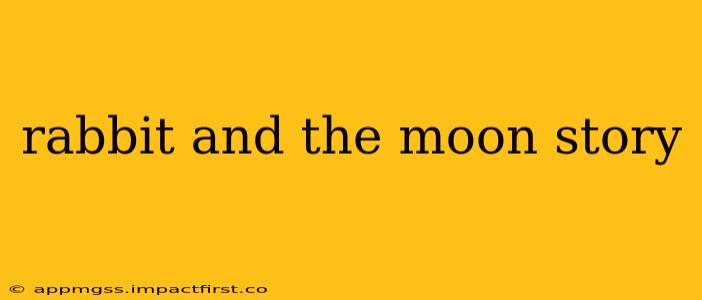The story of the rabbit on the moon is a captivating tale woven into the cultural tapestry of numerous East Asian countries, holding diverse meanings and interpretations across different traditions. This enduring myth, often depicted in art and literature, speaks to our fascination with the celestial and our innate desire to find meaning in the cosmos. But what exactly is this story, and what are its variations?
What is the story of the rabbit in the moon?
The most common version of the story involves a compassionate rabbit who encounters a disguised god (often depicted as an old man, a beggar, or a deity in need). This impoverished figure approaches the rabbit, asking for food. Unlike other animals who offered the god what little they had, the rabbit, possessing nothing but the vegetation it was about to eat, offered itself as a sacrifice, jumping into a fire to provide the god with a meal. Impressed by the rabbit's selfless act, the god placed the rabbit’s image on the moon as a lasting testament to its compassion and sacrifice.
This core narrative varies across cultures. Sometimes the rabbit offers its own body as a sacrifice, while in other versions, it is the god who projects the rabbit's image onto the moon. These variations highlight the diverse interpretations and beliefs surrounding the myth's meaning and significance.
Where did the story of the rabbit in the moon originate?
The exact origins of the rabbit on the moon myth are difficult to pinpoint with absolute certainty. However, the story's presence in various East Asian cultures suggests ancient roots, likely predating written records. Its prevalence in Chinese, Japanese, Korean, and Vietnamese folklore points to a shared cultural heritage and the story's long-lasting impact. Some researchers speculate about connections to ancient animistic beliefs and the early observations of lunar features.
What does the rabbit on the moon symbolize?
The symbolism of the rabbit on the moon is rich and multifaceted. Across different cultures and interpretations, the moon rabbit frequently represents:
- Self-sacrifice and compassion: The central theme revolves around the rabbit's selfless act of offering itself to help those in need. This highlights the values of generosity, empathy, and altruism.
- Purity and innocence: The rabbit, often viewed as a gentle and harmless creature, symbolizes purity and innocence. Its presence on the moon enhances these associations with the celestial body.
- Good fortune and prosperity: In some interpretations, seeing the rabbit on the moon is seen as a lucky omen.
- Perseverance and resilience: The rabbit's willingness to sacrifice itself could also represent perseverance and resilience in the face of adversity.
How is the rabbit on the moon depicted in art and culture?
The moon rabbit is a frequently recurring motif in East Asian art, literature, and popular culture. It is often depicted as pounding mochi (rice cake) in a mortar, preparing an elixir of immortality, or simply resting peacefully on the lunar surface. This iconography adds another layer of meaning and interpretation to the myth. The depiction of the rabbit's actions can vary across different artistic traditions, reflecting unique cultural nuances and beliefs.
Is there a scientific explanation for the "rabbit in the moon"?
From a scientific perspective, the "rabbit" is a pareidolia – our brain's tendency to perceive patterns in random stimuli. The dark markings on the moon's surface, particularly in the maria (dark, basaltic plains), create an illusion that resembles a rabbit (or a man, depending on the cultural interpretation) to some observers.
What other animals are associated with the moon in different cultures?
While the rabbit is prominent in East Asian folklore, other cultures associate different animals with the moon. For example, in some Native American traditions, the moon is connected to the coyote or other significant animals within their belief systems. These variations demonstrate the richness and diversity of lunar mythology around the world.
The story of the rabbit on the moon is more than just a charming tale. It's a testament to the power of mythology to shape cultural values and beliefs, providing a window into the rich history and diverse interpretations of the celestial world across different societies. Its enduring presence in art, literature, and popular culture is a testament to its continuing relevance and enduring appeal.
